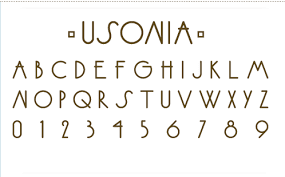ABCs of the USA: The stories behind America's most distinctive calligraphy styles.
Since its arrival 400 years ago, the Roman alphabet has been Americanized in dozens of different versions, by letter artists seeking new ways to reinterpret its clarity, gravitas, and air of permanence. Among them, architect Frank Lloyd Wright (1867-1959) believed that America should move beyond the inherited architecture and letters of Europe, to evolve its own styles. He called this style "Usonian" (United States of North America), and based it on the landscapes of Midwestern prairies, Southwestern deserts, and new cities. Like all American architects, he designed for an idealized future.
 |
| A type style based on Wright's alphabet. |
Wright also insisted that everything in the built environment should harmonize, encompassing textiles, furniture, doorknobs, hinges, and the letters and numerals in the street sign. Often he designed a unique alphabet for a particularly important building.
 |
A typical FLW wall tile from Taliesen (left).


A friend from the world of architecture inspired me to look up more about Marion Mahoney, a gifted designer who worked with him for years. I'm beginning to form an opinion that much of FLW's style IS her work. The Wiki article says "Wright understated the contributions of others of the Prairie School, Mahony included." and "She credited Louis Sullivan as the impetus for the Prairie School philosophy. She thought Wright's habit of taking credit for the movement explained its early death, in the United States." But men taking credit for women's inventions is also part of the American story. Thanks for this contribution, Robin Parkinson.
ReplyDelete